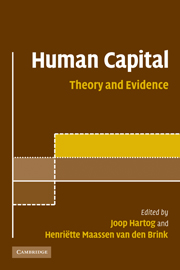Book contents
- Frontmatter
- Contents
- List of figures
- List of tables
- Notes on contributors
- Prologue
- Part I Measuring the benefits from human capital
- 1 What should you know about the private returns to education?
- 2 The social returns to education
- 3 Returns to training
- 4 Human capital and entrepreneurs
- 5 The effects of education on health
- 6 Are successful parents the secret to success?
- Part II Applying and extending the human capital model
- Part III Policy interventions
- Epilogue: some reflections on educational policies
- A note on econometrics
- Index
- References
3 - Returns to training
Published online by Cambridge University Press: 22 September 2009
- Frontmatter
- Contents
- List of figures
- List of tables
- Notes on contributors
- Prologue
- Part I Measuring the benefits from human capital
- 1 What should you know about the private returns to education?
- 2 The social returns to education
- 3 Returns to training
- 4 Human capital and entrepreneurs
- 5 The effects of education on health
- 6 Are successful parents the secret to success?
- Part II Applying and extending the human capital model
- Part III Policy interventions
- Epilogue: some reflections on educational policies
- A note on econometrics
- Index
- References
Summary
Introduction
There is a steadily growing literature that investigates the determinants of individual wage growth over the lifecycle. Understanding wage growth is important for a number of reasons: first, wages are the major determinant of individual welfare; second, because observed wage growth can have several theoretical explanations and distinguishing between these increases our understanding of the functioning of labour markets; and finally, an often mentioned reason is that different components of wage growth are informative about the extent to which wages are tied to jobs, which in turn is a measure of the cost of worker displacement.
The two basic wage growth patterns that have been studied in this context are (i) how wages increase with experience, and (ii) how wages increase with tenure, keeping experience constant. The observed patterns can, however, have many sources. A first explanation is human-capital-based and conjectures that wage growth mirrors productivity growth. A second mechanism that generates wage growth is job search and matching (Jovanovic, 1979a, b; Mortensen, 1978). The intuition is simple: good matches are more likely to survive which generate a positive relation between experience/tenure and wages. All wage growth comes from mobility between jobs rather than from increases in productivity because of human capital investment. Finally contractual considerations can cause wage profiles to slope upwards because postponing rewards can provide an incentive to workers to exert effort early on.
Distinguishing between these alternative explanations of lifecycle wage patterns has proved to be a daunting task.
- Type
- Chapter
- Information
- Human CapitalAdvances in Theory and Evidence, pp. 38 - 51Publisher: Cambridge University PressPrint publication year: 2007
References
- 2
- Cited by



